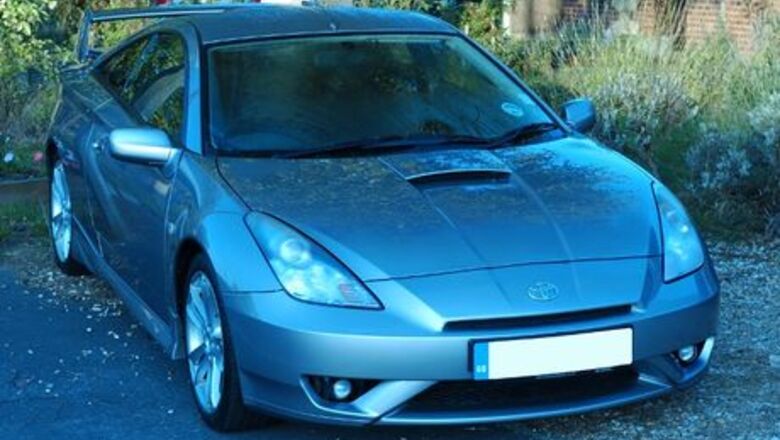
views
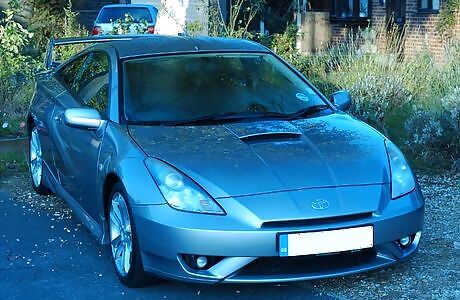
Get your basic settings right. You can read more over at How to Take Better Photographs, but get these basics right: Make sure your white balance is matched to the ambient lighting. Or just shoot raw and fix it later on a computer; whatever works for you. An example of setting it incorrectly; the shot was taken with the setting from the previous night, which was correcting for tungsten lighting. This turned the whole shot blue. Don't do this! Fixing your white balance will vastly improve any photograph you take. Keep your ISO at its lowest. If nothing is moving, and you have the option of shooting from a tripod, you don't need it. Shoot in aperture-priority mode; this way you can shoot for optimal image sharpness and control your depth of field. (Don't worry about this if your camera doesn't have this mode or if you can't be bothered; just shoot in Program). Aperture-priority mode will give you control over your depth of field, and allow you to shoot your lens at the aperture at which it is sharpest.)
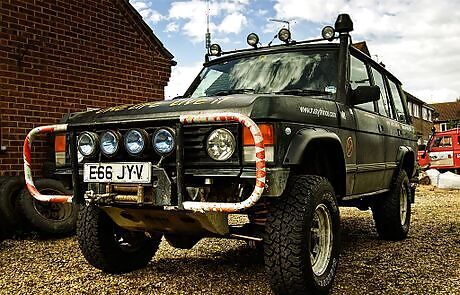
Pick a focal length. Cars have photographic personalities just like people do. Just as some people will look better photographed from a distance with a telephoto and others will by getting up-close and personal, different cars will look better at different zoom settings. Imagine the car was a person: would you want to exaggerate their facial physical features, or de-emphasise them? Wide angles exaggerate a car's features. Does the car look tough and brutish like a prize-fighter? Then zoom out and get closer to the vehicle. Doing this exaggerates perspective.Don't go too wide unless you know what you're doing; a 28mm-equivalent focal length (18mm on your digital SLR's kit lens) is more than wide enough for most of the time. Getting much wider than that, and you'll end up with a photo of a headlight attached to a very small car (which might even be what you want; keep reading!). If your car is more of a prize-fighter like this Range Rover than a supermodel, you might want to use a wider angle to exaggerate the vehicle's features. A normal-to-longer focal length will do the opposite: It'll give a flatter, more elegant look to the vehicle. This is often better for plainer cars, just as longer focal lengths are more flattering to people. Experimenting is free on digital, so don't hesitate to try both. A longer focal length is sometimes more flattering to a vehicle, just like it's more flattering to most people. This was shot with a 50mm lens, which is effectively a short telephoto on a cropped-sensor digital SLR.
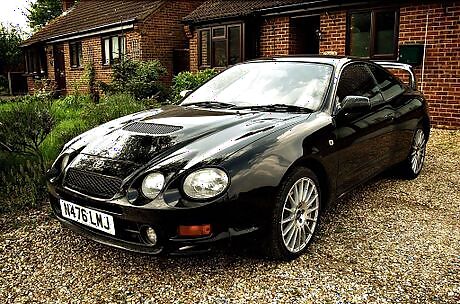
Beware of shininess! It can sometimes be difficult to get a consistent exposure across the whole of a car. The paintwork (hopefully shiny!) will reflect the sky in parts and so will the windscreen, which are extremely bright relative to other parts of the vehicle. Other than bringing in lighting, there's a few ways around this: Use a polarizing filter if you have one. This will cut down the reflections. If you don't have one, consider getting one; they're cheap (and the cheap ones work great) and are one of the two filters most critical for digital photography. Bracket your exposures. You'll need a tripod for this to ensure your photographs line up. Take one photograph at a normal exposure, then take another under-exposed. You can do this using the exposure compensation settings in your camera, or automatic exposure bracketing if your camera has it. You can then use layer masks in your favourite image editing software to paint in areas from the underexposed photo onto parts of the normally-exposed photo (Optionally, you can take a third over-exposed photograph which you can use to fill in shadows in the same way). Exposure bracketing: a normal, underexposed, and overexposed photo. Parts of the darker photo can easily be digitally painted into the overexposed areas of the normal photo. See, in particular, the headlight, which is lacking detail in the normally-exposed photograph.
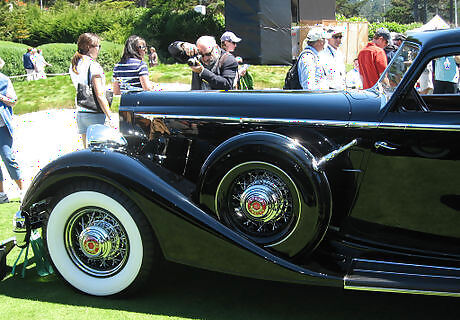
Remove any distractions from the vehicle, just like you'd remove distractions from a photograph of a person. If you're at a car show, wait for people to move out of your shot before taking it. Clear away any litter. Try not to shoot in front of a telephone pole, which will make it look like the pole is poking out of the top of the car. Also, try to avoid pulling too much sky into your photograph; it'll more than likely blow out to a distracting bright cyan or white color if you're not using a gradual neutral-density filter (if you can choose an outdoor location, shooting in front of buildings or other structures that will block out the sky is often a good idea).
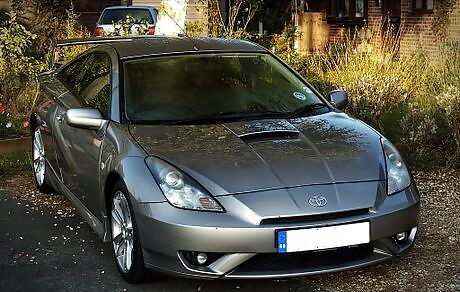
Get away from normal eye-level. Try kneeling or standing on something to make yourself a couple feet taller, or anything that helps you not to get the same eye-level photos that everyone else will be taking. Instead, try these: Kneel down in front of the car. This will give it an aggressive, "coming at you" appearance. Set the camera on the ground. Shooting the car from a very low angle (and tilting it up slightly) will give a unique view that isn't normally seen. Get close and specific. Find the more interesting or unique features or curves on the car, then get close-up shots of them from different angles. Take it from the top. Try to get a shot from high up, or even just holding the camera high above your head. This will both serve as a unique and interesting angle, and allow the photo to capture multiple angles of the car (side, front, top).
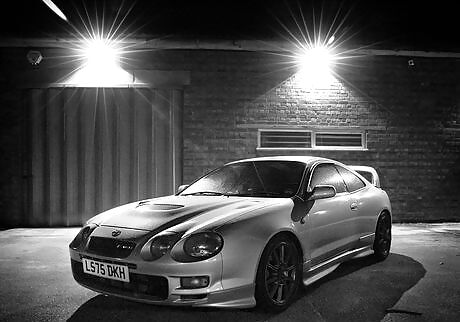
Try shooting at night under artificial lighting. You'll want a tripod for this one, too, and to either use a remote shutter release or a short self-timer.
Stop down to f/8 or f/11. This will turn bright points of light into multi-pointed stars. Make sure your camera's automatic ISO feature is off, and shoot at the lowest ISO setting your camera has. Look at the lighting on the vehicle. Artificial lighting will cast harsh shadows on parts of the car which will need to be filled with your own lighting. You'll get used to these once you can remember that you can see much deeper into the shadows than your camera can. Get your flash off the camera. If it has a built-in flash, then use a compact camera, a camera phone, or any old 1980s flash gun, and quickly run around the vehicle firing the flash to fill in any shadows. (A longer exposure gives you plenty of time to do this, which is another reason to stop down to f/8 or f/11). You might want to drop your photograph down to black-and-white when you're done. Artificial outdoor lighting (especially sodium-vapour) is monochromatic enough that you will probably find that your image is almost black-and-white already once you remove the colour cast from your photograph (a bonus is that this also means you won't have to worry about putting coloured filters over your flash to match the ambient artificial lighting).
Take a variety of photos. Used car buyers will want to know as much about the vehicle as they can. Make sure the photos tell a story of your car - five or more photos is the sweet spot.
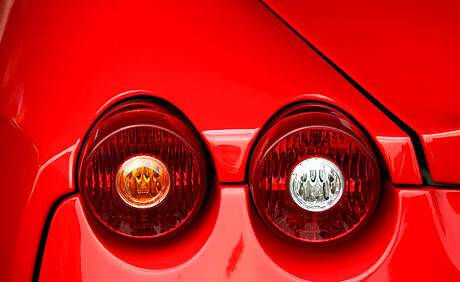
Try cropping really tightly and singling out a single instantly-recognisable feature from the car. This could be a taillight, or a curve on the bodywork, or a crop of quarter of the front grille with a headlight.
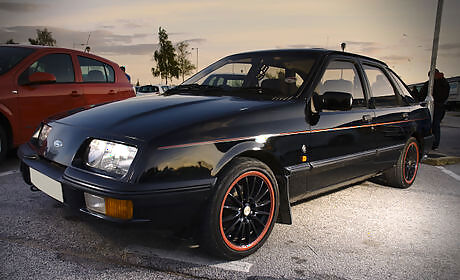
Edit your photographs with your favourite photo editor. If you don't have one, get one; GIMP is free. Some tricks you might want to try are: Use layer masks on an underexposed version of the photo in order to paint in parts of it onto over-exposed parts of your photo (See the information exposure bracketing above). Fix the contrast. More than likely you'll want to increase it. One way which often works brilliantly for cars is to duplicate your image as a layer, set the layer mode to "Soft Light", de-saturate it, then adjust the opacity of that layer to taste. This also has the side-effect of fixing colour casts. The contrast was increased in the GIMP by duplicating the bottom layer, desaturating the new layer and setting the Mode to "Soft Light". (Some distractions in the background were removed as well.) Darken the corners a little to bring attention to the car and de-emphasise the surroundings. Don't go amateur-wedding-photographer-crazy about this; it should be subtle enough that you only notice it if you're looking for it. See How to Add a Vignette to a Photograph with GIMP (these instructions translate almost directly to Photoshop as well). Darkening the edges forces attention towards the subjects. This is deliberately over-done; the effect should be very subtle instead. Remove any other minor distractions you forgot about. This may include litter, for example. The clone brush comes in handy here.




















Comments
0 comment